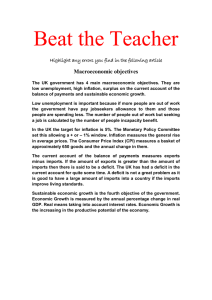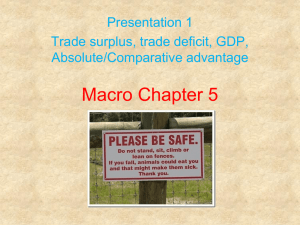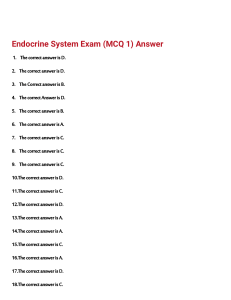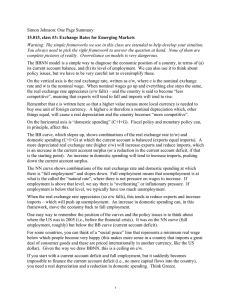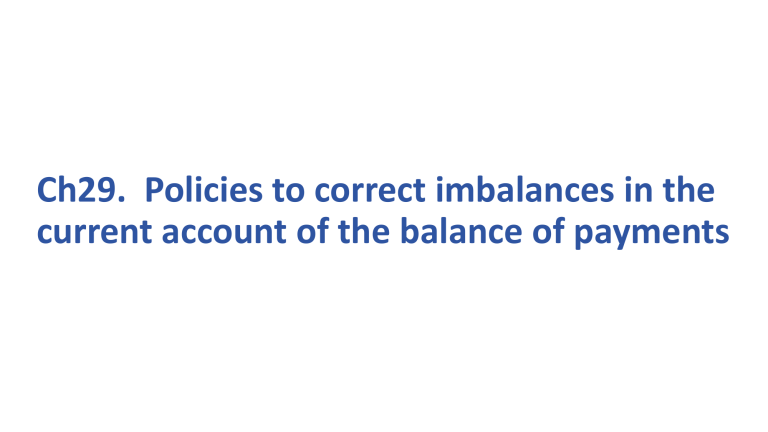
Ch29. Policies to correct imbalances in the current account of the balance of payments Syllabus LEARNING INTENTIONS In this chapter you will learn how to: • explain the government policy objective of stability of the current account • analyse the effect of fiscal, monetary, supply-side and protectionist policies on the current account. 29.1 Government policy objective of stability of the current account 1. Most governments seek to achieve balance of payments stability, with money entering the country equalling money leaving the country. • if export revenue = import expenditure→the country will not get into international debt. • It will also not be giving up the opportunity to buy foreign products that it can afford. 2. In the short run, a government may welcome more being spent on imports than earned from exports if this arises from more raw materials and capital goods being imported. • A deficit also allows a country to consume more goods and services than it is producing. • Alternatively, a government may encourage a surplus of export revenue over import expenditure in order to boost aggregate demand and to provide funds to repay external debt. 29.2 The effect of fiscal policy on the current account 1. If a country is experiencing a deficit on the current account of its balance of payments, it may use a variety of fiscal policy tools. • contractionary fiscal policy: income tax↑ , government spending↓→to reduce demand for goods and services including imports • income tax↑ →disposable income↓→less income for households to spend on imports as well as domestic products • government spending↓ →reduce demand for goods and services→reduce imports and put pressure on domestic firms to increase their exports 2. If a government is seeking to reduce a current account surplus, it could use expansionary fiscal policy. • income tax↓ ,government spending(state pensions)↑ → consumer expenditure↑ • More imports will be purchased and some products may be diverted from the export market to the home market 3. Fiscal policy measures may alter a country’s current account position in the short term but are unlikely to be a long-term solution. • This is because once the policy measures are stopped, households and firms are likely to go back to spending the same amount on imports relative to the amount of export revenue earned. 4. Raising taxes may also have adverse side effects. • They lower demand→ increase unemployment and slow economic growth. • Higher taxation can also create disincentive effects and so may reduce aggregate supply. 29.3 The effect of monetary policy on the current account 1. Reducing the growth of the money supply may be used to reduce the growth in spending on imports. • it can be difficult to control the money supply (see Section 23.2). 2. Changing the rate of interest to influence the current account position is a more complex process. • If an economy has a low rate of inflation and a current account deficit, its central bank may reduce the interest rate in an attempt to put downward pressure on a floating exchange rate. • A lower exchange rate → the country’s products becoming more internationally competitive→a risk it may generate inflationary pressure • A higher interest rate → cutting consumer expenditure→reducing demand for imports and reducing inflationary pressure. • It may raise a floating exchange rate that could reverse the fall in demand for imports. 3. To reduce a current account surplus, a government may seek to increase consumer expenditure by using expansionary monetary policy. • money supply↑, interest rate↓→encourage an appreciation of the exchange rate. 4. Most monetary policy tools are not likely to be effective in reducing imbalances in the current account of the balance of payments in the long-term. • Because they are unlikely to be tackling the structural weaknesses in the economy, such as low productivity, which are causing a current account deficit. • They may not have any long-term effect on structural strengths, such as a high rate of innovation and ownership of scarce raw materials, which are causing a current account surplus. 29.4 The effect of supply-side policy on the current account 1. Supply-side policy tools may reduce a current account deficit by making domestic products more price competitive and by making domestic markets more attractive to invest in. • e.g.: deregulation and privatisation may increase the competitive pressure on domestic firms to keep costs and prices low, to improve quality and to become more responsive to changes in consumer demand. 2. Increased spending on education and training and increased investment subsidies may also increase exports. • A more skilled labour force and better capital equipment may reduce the relative price of domestic output and raise its quality. Both of these effects will be likely to increase domestic firms’share of the home market and the international market. • A skilful labour force and good-quality capital equipment may also attract foreign multinational companies (MNCs) to set up a local branch in the country in expectation they will be able to produce good-quality products at low cost. Such multinational companies may contribute to the country’s exports. 3. Trade union reform may enable domestic firms to work with more flexibility and so be more responsive to changes in demand. • A resulting fall in industrial action combined with greater flexibility may make foreign firms more willing to buy the country’s exports. 4. Supply-side policy is unlikely to be a quick way of correcting imbalances in the current account of the balance of payments. • It is also not designed to reduce a current account surplus as it seeks to increase the quantity and quality of the country’s resources. It has the potential to correct a deficit in the current account in the long run. 29.5 The effect of protectionist policy on the current account • Protectionist policy can be used as a way of encouraging domestic consumers and firms to switch to buying domestic products. • For instance, a government could impose a tariff or increase an existing tariff on imports. Such a measure works more effectively when high quality substitutes produced by domestic firms are available. • Imposing tariffs against trading partners in a trade bloc is not an option. Imposing or increasing tariffs against other countries involves two risks. • it may provoke retaliation • it may reduce the pressure on domestic firms to become more efficient. MCQ MCQ MCQ MCQ MCQ

